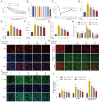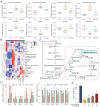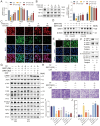Catalpol attenuates hepatic glucose metabolism disorder and oxidative stress in triptolide-induced liver injury by regulating the SIRT1/HIF-1α pathway
- PMID: 39113710
- PMCID: PMC11302874
- DOI: 10.7150/ijbs.97362
Catalpol attenuates hepatic glucose metabolism disorder and oxidative stress in triptolide-induced liver injury by regulating the SIRT1/HIF-1α pathway
Abstract
Triptolide (TP), known for its effectiveness in treating various rheumatoid diseases, is also associated with significant hepatotoxicity risks. This study explored Catalpol (CAT), an iridoid glycoside with antioxidative and anti-inflammatory effects, as a potential defense against TP-induced liver damage. In vivo and in vitro models of liver injury were established using TP in combination with different concentrations of CAT. Metabolomics analyses were conducted to assess energy metabolism in mouse livers. Additionally, a Seahorse XF Analyzer was employed to measure glycolysis rate, mitochondrial respiratory functionality, and real-time ATP generation rate in AML12 cells. The study also examined the expression of proteins related to glycogenolysis and gluconeogenesis. Using both in vitro SIRT1 knockout/overexpression and in vivo liver-specific SIRT1 knockout models, we confirmed SIRT1 as a mechanism of action for CAT. Our findings revealed that CAT could alleviate TP-induced liver injury by activating SIRT1, which inhibited lysine acetylation of hypoxia-inducible factor-1α (HIF-1α), thereby restoring the balance between glycolysis and oxidative phosphorylation. This action improved mitochondrial dysfunction and reduced glucose metabolism disorder and oxidative stress caused by TP. Taken together, these insights unveil a hitherto undocumented mechanism by which CAT ameliorates TP-induced liver injury, positioning it as a potential therapeutic agent for managing TP-induced hepatotoxicity.
Keywords: Catalpol; Drug-induced liver injury; Energy metabolism; Hypoglycemia; Oxidative stress.
© The author(s).
Conflict of interest statement
Competing Interests: The authors have declared that no competing interest exists.
Figures







Similar articles
-
Catalpol coordinately regulates phase I and II detoxification enzymes of Triptolide through CAR and NRF2 pathways to reduce Triptolide-induced hepatotoxicity.Biomed Pharmacother. 2020 Sep;129:110379. doi: 10.1016/j.biopha.2020.110379. Epub 2020 Jun 17. Biomed Pharmacother. 2020. PMID: 32563148
-
Catalpol and panax notoginseng saponins synergistically alleviate triptolide-induced hepatotoxicity through Nrf2/ARE pathway.Toxicol In Vitro. 2019 Apr;56:141-149. doi: 10.1016/j.tiv.2019.01.016. Epub 2019 Jan 23. Toxicol In Vitro. 2019. PMID: 30682494
-
Triptolide regulates oxidative stress and inflammation leading to hepatotoxicity via inducing CYP2E1.Hum Exp Toxicol. 2021 Dec;40(12_suppl):S775-S787. doi: 10.1177/09603271211056330. Epub 2021 Nov 11. Hum Exp Toxicol. 2021. PMID: 34758665
-
Alleviation effect of macrophage depletion on hepatotoxicity of triptolide: A new insight based on metabolomics and proteomics.J Ethnopharmacol. 2025 Mar 13;343:119485. doi: 10.1016/j.jep.2025.119485. Epub 2025 Feb 11. J Ethnopharmacol. 2025. PMID: 39947369
-
Arctiin Antagonizes Triptolide-Induced Hepatotoxicity via Activation of Nrf2 Pathway.Biomed Res Int. 2020 Oct 16;2020:2508952. doi: 10.1155/2020/2508952. eCollection 2020. Biomed Res Int. 2020. PMID: 33123566 Free PMC article.
Cited by
-
SIRT1 Alleviates Mitochondrial Fission and Necroptosis in Cerebral Ischemia/Reperfusion Injury via SIRT1-RIP1 Signaling Pathway.MedComm (2020). 2025 Feb 24;6(3):e70118. doi: 10.1002/mco2.70118. eCollection 2025 Mar. MedComm (2020). 2025. PMID: 40008377 Free PMC article.
-
Involvement of intestinal mucosal microbiota in adenine-induced liver function injury.3 Biotech. 2025 Jan;15(1):6. doi: 10.1007/s13205-024-04180-7. Epub 2024 Dec 12. 3 Biotech. 2025. PMID: 39676888
-
Multifaceted therapeutic potentials of catalpol, an iridoid glycoside: an updated comprehensive review.Inflammopharmacology. 2025 Mar 17. doi: 10.1007/s10787-025-01694-1. Online ahead of print. Inflammopharmacology. 2025. PMID: 40097877 Review.
-
Catalpol Research on the Mechanism of Antimyocardial Reperfusion Injury by Regulating the MiR-126/TWEAK-FN14 Pathway: In Vitro and Computer Simulation Studies.ACS Omega. 2025 May 9;10(19):19538-19551. doi: 10.1021/acsomega.4c11357. eCollection 2025 May 20. ACS Omega. 2025. PMID: 40415811 Free PMC article.
-
[Catalpol reduces liver toxicity of triptolide in mice by inhibiting hepatocyte ferroptosis through the SLC7A11/GPX4 pathway: testing the Fuzheng Zhidu theory for detoxification].Nan Fang Yi Ke Da Xue Xue Bao. 2025 Apr 20;45(4):810-818. doi: 10.12122/j.issn.1673-4254.2025.04.16. Nan Fang Yi Ke Da Xue Xue Bao. 2025. PMID: 40294931 Free PMC article. Chinese.
References
-
- Zhao Z, Huang H, Ke S, Deng B, Wang YX, Xu N. et al. Triptolide inhibits the proinflammatory potential of myeloid-derived suppressor cells via reducing Arginase-1 in rheumatoid arthritis. Int Immunopharmacol. 2024;127:111345. - PubMed
-
- Xi C, Peng S, Wu Z, Zhou Q, Zhou J. Toxicity of triptolide and the molecular mechanisms involved. Biomed Pharmacother. 2017;90:531–541. - PubMed
MeSH terms
Substances
LinkOut - more resources
Full Text Sources
Miscellaneous

